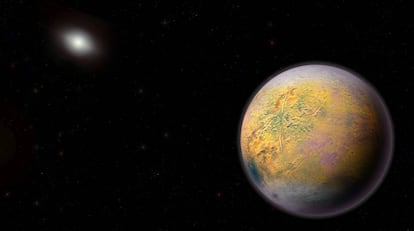Planet X: a new member of the Solar System club?
The existence of a new planetary body could explain the peculiar movements of celestial objects orbiting beyond Neptune

Paraphrasing Rutger Hauer’s soliloquy at the end of Ridley Scott’s 1982 sci-fi classic Blade Runner, we can say, and it would be true, that we have seen things you wouldn’t believe: bodies of ice beyond Neptune’s orbit, dwarf planets, objects that move with elongated orbits, orbital planets that display the same angle of inclination, perihelia that extend beyond the gravitational influence of Neptune… but all of this information will not be lost in time, like tears in rain. And now the time has come to figure out what exactly is happening with Planet 9, or Planet X.
From childhood we are made aware of and dedicate songs to the architecture of our wider home, the Solar System: a star surrounded by eight planets, the closest to the Sun, Mercury, and the furthest away, Neptune. The majority of the planets (with the exceptions of Uranus and Neptune) were known to science in antiquity and in that sense, we have made few advances since the invention of the telescope. Over the last few years, however, we have discovered a series of huge rocky objects beyond Neptune that we have grouped together under the name of trans-Neptunian objects, also known as the Kuiper belt in honor of astronomer Gerard Kuiper, who predicted its existence in 1951. The belt consists of thousands of icy bodies, the majority of which are smaller than Texas (if it was three-dimensional) and that are, literally, the debris from the formation of the Solar System. The Kuiper belt contains a couple of objects that are very famous: one is Pluto, the other is Arrokoth (which means sky or cloud in the Powhatan language), previously known as Ultima Thule, and the most distant object studied in space by a spacecraft to date when New Horizons made a flyby on January 1, 2019.
Planet X would be a big planet with a mass of between five and 10 times greater than Earths’
Most of the objects in the Kuiper belt move much as would be expected due to the mutual gravitational influence generated by the presence of the eight planets and the Sun. Up to that point, everything is in order. However, a problem arises because since 2004, a series of objects have been identified making peculiar movements in this zone of the Solar System. It is like looking at a moving swing in a tree with nobody sitting on it: we know that someone must be pushing it. These “strange” movements gave rise to a thesis, put forward in 2016, of the existence of an additional planet beyond Neptune’s orbit that has not yet been detected. This potential planet has become known colloquially as Planet 9, or Planet X.
It is not the first time that the anomalous orbital behavior of known objects has led to a new discovery. Neither will it be the first time that it has led to nothing more than an improved revision of the measurements. But as we have the news to provide us with tales of failure every day, let’s focus on a success story that started with William Herschel’s discovery in 1781 of a new member of the Solar System, Uranus. The newly discovered planet had a long orbit – 84 years – and in the 60 years after Herschel’s telescope alighted on it excited astronomers set themselves to the task of calculating its ephemerides (a table of values that provides the position of astrological objects in the sky at a given time), based on the positions of the known planets up to that point.
The problem was that the calculations and observations did not add up, which led French mathematician Urbain Le Verrier to propose, in 1846, the existence of another planet further afield to explain the differences. The planet that was causing these anomalies was discovered the same year, very close to its predicted position, and was named Neptune.
With the mathematical discovery of Neptune we were on a roll and the unexplained movements of objects in the Solar System continued to inspire predictions of the existence, and often the location, of further objects in our immediate vicinity. As such, and despite the addition of Neptune to the calculations, small discrepancies in the observed and calculated orbits of the giant planets remained, resulting in the search for a Planet X and the construction of the Lowell Observatory in Arizona, which eventually led to the discovery of Pluto.
Pluto was downgraded to a dwarf planet in 2006 and returning to the story at hand, it had considerably less mass – around 3,200 times less – than the Planet X that was being sought. Finally, the revised measurements of Neptune’s size provided by the Voyager 2 probe untangled the discrepancies of the orbits of the giant planets and eliminated the necessity for a massive additional body within the confines of the Solar System. Until a few years ago.
These “strange” movements of objects in the Kupier belt gave rise to a thesis of the existence of an additional planet beyond Neptune’s orbit
Over the past few years, data has been compiled on peculiar orbital patterns in some objects beyond Neptune’s orbital sphere. These are bodies that move with elongated orbits, in ellipses oriented in the same direction, on plains inclined with the same angle and with orbits, in some cases, that run in the opposite direction to normal. This cannot be explained by the influence of the massive bodies that we know of and suggests the possible existence of a planet that we have not yet seen but which would be between 300 and 800 times further away from the Sun than the Earth is. It would be a big planet with a mass of between five and 10 times greater than ours’, with a moderately inclined (15-20 degrees) and elongated orbit. Above all, it would be a planet that will be very difficult – but not impossible – to detect over the course of the next decade and one whose process of formation, due to the huge distance between it and the Sun, also presents a formidable problem.
It is in that population of dispersed debris, scattered between Neptune’s orbit and the confines of the Solar System – the heliosphere – where right now, like the devil in the detail, the history of the Solar System, its dynamic evolution and possibly a new planet are hidden. As is so often the case in life, it is not uncommon that we don’t find something that could be, perhaps quite literally, under our very noses.
Eva Villaver is an astrophysicist and researcher at the Spanish Astrobiology Center, which is part of the Spanish National Research Council and the National Institute of Aerospace Technology (CAB/CSIC-INTA).
English version by Rob Train.
Tu suscripción se está usando en otro dispositivo
¿Quieres añadir otro usuario a tu suscripción?
Si continúas leyendo en este dispositivo, no se podrá leer en el otro.
FlechaTu suscripción se está usando en otro dispositivo y solo puedes acceder a EL PAÍS desde un dispositivo a la vez.
Si quieres compartir tu cuenta, cambia tu suscripción a la modalidad Premium, así podrás añadir otro usuario. Cada uno accederá con su propia cuenta de email, lo que os permitirá personalizar vuestra experiencia en EL PAÍS.
¿Tienes una suscripción de empresa? Accede aquí para contratar más cuentas.
En el caso de no saber quién está usando tu cuenta, te recomendamos cambiar tu contraseña aquí.
Si decides continuar compartiendo tu cuenta, este mensaje se mostrará en tu dispositivo y en el de la otra persona que está usando tu cuenta de forma indefinida, afectando a tu experiencia de lectura. Puedes consultar aquí los términos y condiciones de la suscripción digital.
More information
Archived In
Últimas noticias
Most viewed
- Sinaloa Cartel war is taking its toll on Los Chapitos
- Reinhard Genzel, Nobel laureate in physics: ‘One-minute videos will never give you the truth’
- Oona Chaplin: ‘I told James Cameron that I was living in a treehouse and starting a permaculture project with a friend’
- Why the price of coffee has skyrocketed: from Brazilian plantations to specialty coffee houses
- David King, chemist: ‘There are scientists studying how to cool the planet; nobody should stop these experiments from happening’











































